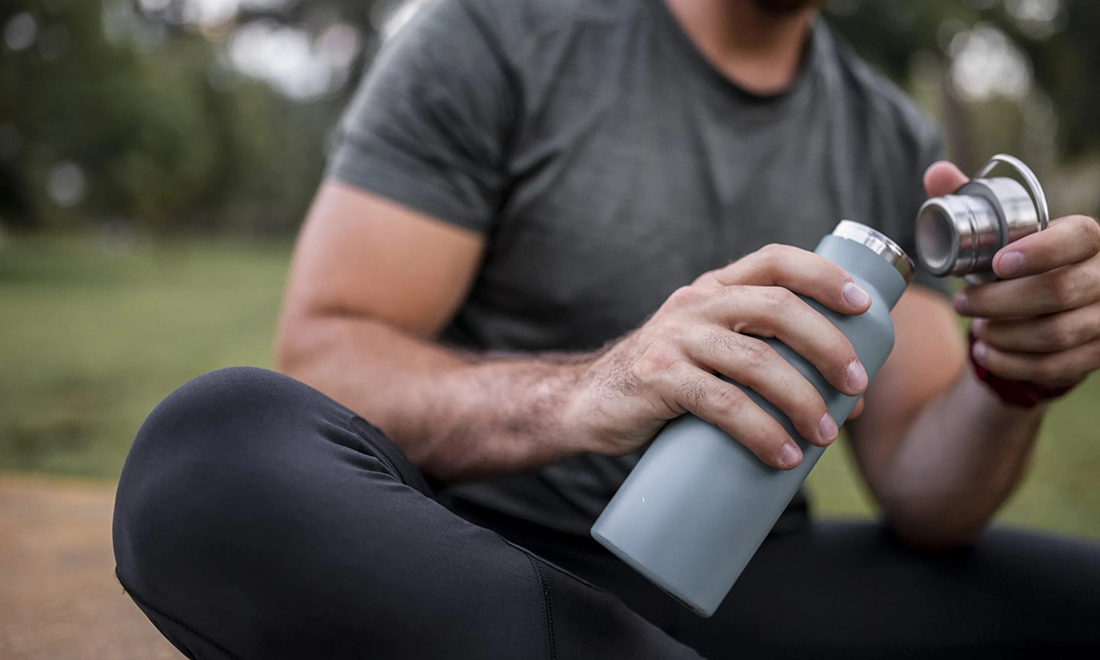
和许多人一样,卡尔·贝恩克(Carl Behnke)每天都会随身携带水瓶,以确保自己能及时补充水分。从办公室到健身房,再返回家中,贝恩克几乎时刻都不离其左右。但贝恩克同时也是普渡大学(Purdue University)酒店与旅游管理学院的副教授,他在清洗水瓶时发现水瓶内壁上有一层“生物膜”,这不禁令他陷入沉思。他解释道:“我意识到自己在清洗水瓶方面,或许并未达到应有的认真程度。这使我心生好奇:对于了解食品安全的人来说尚且如此,其他人又会怎样呢?”
这个问题促使贝恩克和一批学者及科学家开展了一项研究,旨在探究可重复使用水瓶的污染程度如何受到使用和清洁行为的影响。如果你经常使用可重复使用水瓶饮水,那么他们的研究成果或许会让你重新审视自己清洁水瓶的方式。
改变习惯
虽然整天随身携带可重复使用水瓶对健康和环境都有益,但忽视对它的清洁则可能会导致一些不良后果。贝恩克问道:“你会在晚饭后清洗餐具吗?答案是确定的,但对于水瓶,我们经常把它们带到各处,却未能妥善清洁。”
你可能会把水瓶冲洗干净,但倘若未能按照应有的频率进行恰当清洗,那么对于瓶子表面及内部可能滋生的细菌,你会倍感惊诧。这项研究包括两部分调查问卷,由水瓶使用者填写。第一组问题主要涉及使用的水瓶类型、使用年限、瓶内所盛之物(水、能量饮料等)以及使用频率。第二部分则侧重于清洁行为,包含从清洁方法到清洁频率等方面。
贝恩克说,从根本上说,典型的水瓶使用方式具备了滋生细菌的所有条件:潮湿、污染以及通常处于较高温度环境。贝勒医学院(Baylor College of Medicine)传染病医学助理教授福田由里子(Yuriko Fukuta)博士对此表示赞同。她说:“我们频繁地用嘴和手接触水瓶,因此极易将细菌传播给水瓶,然后细菌就会滋生。在某些情况下,这可能会让你生病,尤其是当你的免疫系统较弱时。”
福田指出,细菌可能包含葡萄球菌或链球菌。而该项合作研究还表明:“我们的样本中,有超过20%的样本含有大肠杆菌,也就是粪便污染滋生的细菌,”贝恩克说。
水瓶的正确护理和清洁方法
倘若瓶内的细菌让你想要正确对待水瓶,以下是一些应遵循的注意事项:
• 仅在瓶内装水,以减少细菌滋生。能量饮料、茶或其他粉末及添加剂只会增加细菌滋生的几率。
• 避免将水瓶置于可能升温的区域。福田表示:“切勿将水瓶留置车内,而后饮用其中的水。高温与时间会加速细菌的滋生。”
• 贝恩克建议,每日使用后对水瓶进行冲洗。
• 每周进行一次彻底清洁,最好用专门的瓶刷手工清洗。清洁完毕后,将其倒置在晾干架上直至完全晾干——切勿将潮湿的瓶子收起来。
• 避免与他人共用水瓶。贝恩克表示:“若仅是你的唾液与水,问题不大。但倘若与他人共用,会引入其他污染物。”
减少细菌滋生的最佳水瓶类型
福田认为,最佳选择是宽口瓶,这样的水瓶易于清洗和晾干,以及带有内置吸管的水瓶,可以尽可能地避免手接触瓶口。
如果你旨在防止水瓶沦为细菌滋生的温床,最为简便的方法就是贝恩克在进行研究后所采用方式。他说道:“我每天用水冲洗一次水瓶,每周使用优质洗涤剂、瓶刷和高乐氏(Clorox)漂白水清洗一次。”(财富中文网)
译者:中慧言-王芳
和许多人一样,卡尔·贝恩克(Carl Behnke)每天都会随身携带水瓶,以确保自己能及时补充水分。从办公室到健身房,再返回家中,贝恩克几乎时刻都不离其左右。但贝恩克同时也是普渡大学(Purdue University)酒店与旅游管理学院的副教授,他在清洗水瓶时发现水瓶内壁上有一层“生物膜”,这不禁令他陷入沉思。他解释道:“我意识到自己在清洗水瓶方面,或许并未达到应有的认真程度。这使我心生好奇:对于了解食品安全的人来说尚且如此,其他人又会怎样呢?”
这个问题促使贝恩克和一批学者及科学家开展了一项研究,旨在探究可重复使用水瓶的污染程度如何受到使用和清洁行为的影响。如果你经常使用可重复使用水瓶饮水,那么他们的研究成果或许会让你重新审视自己清洁水瓶的方式。
改变习惯
虽然整天随身携带可重复使用水瓶对健康和环境都有益,但忽视对它的清洁则可能会导致一些不良后果。贝恩克问道:“你会在晚饭后清洗餐具吗?答案是确定的,但对于水瓶,我们经常把它们带到各处,却未能妥善清洁。”
你可能会把水瓶冲洗干净,但倘若未能按照应有的频率进行恰当清洗,那么对于瓶子表面及内部可能滋生的细菌,你会倍感惊诧。这项研究包括两部分调查问卷,由水瓶使用者填写。第一组问题主要涉及使用的水瓶类型、使用年限、瓶内所盛之物(水、能量饮料等)以及使用频率。第二部分则侧重于清洁行为,包含从清洁方法到清洁频率等方面。
贝恩克说,从根本上说,典型的水瓶使用方式具备了滋生细菌的所有条件:潮湿、污染以及通常处于较高温度环境。贝勒医学院(Baylor College of Medicine)传染病医学助理教授福田由里子(Yuriko Fukuta)博士对此表示赞同。她说:“我们频繁地用嘴和手接触水瓶,因此极易将细菌传播给水瓶,然后细菌就会滋生。在某些情况下,这可能会让你生病,尤其是当你的免疫系统较弱时。”
福田指出,细菌可能包含葡萄球菌或链球菌。而该项合作研究还表明:“我们的样本中,有超过20%的样本含有大肠杆菌,也就是粪便污染滋生的细菌,”贝恩克说。
水瓶的正确护理和清洁方法
倘若瓶内的细菌让你想要正确对待水瓶,以下是一些应遵循的注意事项:
• 仅在瓶内装水,以减少细菌滋生。能量饮料、茶或其他粉末及添加剂只会增加细菌滋生的几率。
• 避免将水瓶置于可能升温的区域。福田表示:“切勿将水瓶留置车内,而后饮用其中的水。高温与时间会加速细菌的滋生。”
• 贝恩克建议,每日使用后对水瓶进行冲洗。
• 每周进行一次彻底清洁,最好用专门的瓶刷手工清洗。清洁完毕后,将其倒置在晾干架上直至完全晾干——切勿将潮湿的瓶子收起来。
• 避免与他人共用水瓶。贝恩克表示:“若仅是你的唾液与水,问题不大。但倘若与他人共用,会引入其他污染物。”
减少细菌滋生的最佳水瓶类型
福田认为,最佳选择是宽口瓶,这样的水瓶易于清洗和晾干,以及带有内置吸管的水瓶,可以尽可能地避免手接触瓶口。
如果你旨在防止水瓶沦为细菌滋生的温床,最为简便的方法就是贝恩克在进行研究后所采用方式。他说道:“我每天用水冲洗一次水瓶,每周使用优质洗涤剂、瓶刷和高乐氏(Clorox)漂白水清洗一次。”(财富中文网)
译者:中慧言-王芳
Like many people, Carl Behnke regularly totes a water bottle around throughout his day to make sure he stays hydrated. From the office to the gym and back home again, Behnke is rarely without it. But Behnke is also an associate professor in the school of hospitality and tourism management at Purdue University, and when he discovered a “biofilm” on the inside of his water bottle while cleaning it, it got his wheels turning. “I realized I probably wasn’t as diligent about cleaning my water bottle as I should be,” he explains. “And that made me curious: If someone who knows about food safety isn’t diligent, what about everyone else?”
That question led to a study, conducted by Behnke and a cohort of academics and scientists, into how reusable-bottle contamination levels are affected by usage and cleaning behaviors. If you’re regularly drinking water from a reusable bottle, their findings might prompt you to reconsider your own water-bottle-handling practices.
Change your habits
While carrying around a reusable water bottle all day is healthy for you—and good for the environment—neglecting its care could lead to some negative consequences. “Do you wash your dishes after dinner?” asks Behnke. “Yes. But with water bottles, we often take them all over the place and don’t properly clean them.”
You might rinse your bottle out, but if you don’t wash it properly as often as you should, you’d be surprised at what might be growing on the surface and on the inside. The study consisted of two sections of surveys filled out by water-bottle users. The first set of questions centered on the type and age of bottle they used, what they put inside it (water, energy drinks, et cetera), and their frequency of use. The second section focused on cleaning behaviors, from the method to the frequency.
Essentially, said Behnke, typical water-bottle use has all the ingredients to foster bacterial growth: moisture, contamination, and, often, warm temperatures. Dr. Yuriko Fukuta, assistant professor of medicine–infectious diseases at Baylor College of Medicine, agrees. “We’re constantly touching our water bottles with our mouths and hands, so it’s easy to transmit bacteria to them, and then it just grows,” she says. “In some cases this can make you sick, especially if you have a weaker immune system.”
Fukuta suggested that bacteria might include staph or strep. And there’s this, from the cohort study: “More than 20% of our samples had coliform bacteria, which is fecal matter,” says Behnke.
Proper care and cleaning for water bottles
If all that bacteria has you wanting to do right by your water bottle, there are a few dos and don’ts to follow:
• Stick to just water in your bottles to lessen bacterial growth. Energy drinks, tea, or other powders and add-ins will only increase the likelihood of bacterial growth.
• Keep your water bottles out of spots where they might heat up. “Don’t leave your water bottle inside your car and then drink from it,” says Fukuta. “Warm temperatures and time accelerate the growth of germs.”
• Rinse it after every day’s use, recommends Behnke.
• Give it a good washing once a week, preferably by hand and with a special bottle brush. When finished, leave it upside down on a drying rack to dry completely—don’t put your bottles away wet.
• Avoid sharing water bottles with anyone else. “If it’s your saliva and just water, it’s not a big deal,” says Behnke. “But if you share, you’re introducing other contaminants.”
The best type of water bottle for mitigating bacterial growth
According to Fukuta, your best bets are bottles with a wide mouth, which make them easy to clean and dry, and those with a built-in straw that keeps your hands away if possible.
If your goal is to keep your water bottle from turning into a germy breeding ground, the simplest approach is Behnke’s, which he changed after conducting the research. “I rinse my bottle once a day,” he says, “and wash it once a week, using good detergent, a bottle brush, and a spray of Clorox bleach.”






